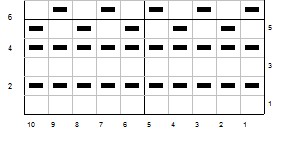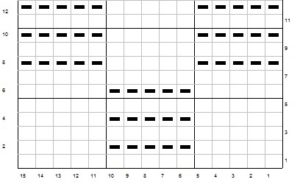Linen is for Summer Crafting
In the summer, it’s too hot to be working with a big wool project. One thing I like to work on is guest towels, because they make great gifts (and to be completely honest, I love them myself!). You don’t need a pattern, just a basic concept. Sport weight linen knits to about 6 stitches per inch. Here are the steps I use to create one of a kind fancy guest towels. Remember, this is a towel, 1 stitch or row doesn’t really matter!
1) Choose a size. A large hand towel is about 11-12 inches wide by 22-24 inches long. This is the size most often found in a 3-piece terry towel set including bath+hand+washcloth. It will take about 100g of sport weight linen. A smaller guest towel is about half as big, about 6-7 X 15-18 inches and takes about 50g. These measurements have a lot of leeway, so you can fit the size to the stitch pattern you want to use.
2) Choose a stitch pattern you like, but make sure it is a combination of only knit and pearl stitches. You need a flat fabric to make a functional towel that will launder well. No lace, cables, bobbles, slip or tuck stitches. Take note of the number of stitches in the pattern repeat.
3) Choose the number of stitches to cast on. Figure how many whole repeats of your chosen stitch pattern will fit into the width you want. Your towel needs a picture frame of a non-rolling stitch such as seed stitch or garter stitch to help it stay flat. Your picture frame needs to be 5-8 stitches on each side and 5-8 rows on each end, so you need to include these stitches in the total to cast on. Examples: Let’s say you want the big towel, 12 inches wide, and 6 st/inch = 72. Your pattern is 15 st, and 15 X 4 = 60. 15 X 5 is 75, which will be too many. So you have 4 repeats plus 6 st on each side.
That one was pretty easy. Here’s a slightly more complicated example. Your pattern is 8 st plus 5 (those extra stitches allow for centering and so forth). 1 repeat only is 13 st, but 2 repeats is 21 st (not 26) because the “plus 5 st” is only counted once in each row. So if we are aiming for about 72 stitches across, we might choose 6 repeats, which is 63 st (6 X 8=43+5=63). That leaves only 9 st to get to 72, but we want the picture frame to be the same on each side, so we add a stitch and settle on 73 st to cast on. It doesn’t matter how many repeats or stitches in the borders as long as you get close to the size you want. So cast on however many stitches you have figured out–72 in the first example, 73 in the second.
4) Remember you are making a picture frame around the rectangle, so if the picture frame is 5 st on each side, you will start by knitting 5 rows of your non-rolling pattern for the beginning border. After the beginning border, you will work that many stitches in border, X repeats of your main pattern, and at the end add border st. When you get to the length you want (I try to make it at the end of a full repeat) you will work the ending border same as the first.
So here are some stitch patterns to get you started, and every one will make a gorgeous towel. Blank squares are knit, dashed squares are purl. All charts are read right to left on odd rows, l to r on even rows. All of these patterns look great on either side. This is a simple stripe pattern of stockinette and seed stitch, that only requires any even number of stitches. It’s very flexible, and if you use seed stitch for the border, the seed stitch stripe will come floating out of the border if you make the border an even number of st on each side.
This is a simple stripe pattern of stockinette and seed stitch, that only requires any even number of stitches. It’s very flexible, and if you use seed stitch for the border, the seed stitch stripe will come floating out of the border if you make the border an even number of st on each side.
 This is a simple garter block. The repeat is 10 st, and the last 5 are to balance the pattern. That is, this pattern has a repeat of 10 st plus 5.
This is a simple garter block. The repeat is 10 st, and the last 5 are to balance the pattern. That is, this pattern has a repeat of 10 st plus 5.

This is a simple basket weave. It is a multiple of 8 st, plus 5, but not easy to see in the chart. So in the first 4 rows, the repeat returns from st 12 to st 6, and in rows 5-8 (WS row) goes from st 12 through st 6.
This is a pattern that is harder to “see” in a chart than in the knitting. This is a diagonal pattern, 4 st of knit or purl overlapped by one. This is easy to see in the chart, even though the repeat is a multiple of 8 st plus 6, which seems complicated. But it isn’t at all–once you have knit 3-4 rows, it will be a no-brainer.
This is a diagonal pattern, 4 st of knit or purl overlapped by one. This is easy to see in the chart, even though the repeat is a multiple of 8 st plus 6, which seems complicated. But it isn’t at all–once you have knit 3-4 rows, it will be a no-brainer.
So why not go for it? You’ll find these small towel projects are fun to knit, easy to carry around, and so appreciated if you gift them.
Right now (May 17-25, 2017) we have the Universal Flax sport weight linen on sale for 4.99/50g. Go see it here.